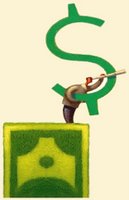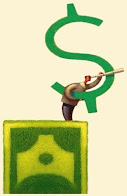
On
Friday, the Federal minimum wage will rise from $6.55 per hour to $7.25. The timing of this increase couldn't be worse, in my opinion, as small businesses across the country are already hurting in this deep recession. $0.70 might not seem like much, but for the small business owner who's barely making it -- the one who's already seriously worried about the future; the one who's having a real hard time finding financing; the one who's already been contemplating cutting his or her workforce -- it could mean the difference between keeping 400 employees working full time, or cutting back to 300. Moreover, the labor cost increase will likely prompt many employers to cut back on employee hours. This is no time to throw obstacles in the way of an economic recovery.
Will the increase help the economic recovery? I really don't think so. If you were making minimum wage right now, and all of a sudden you got an extra $39.20 in your pocket each week, would you spend it, knowing that, in this economy, your job could disappear in a flash? Is an extra $156.80 per month going to help that family who got an adjustable rate mortgage (ARM) during the boom -- you know, that mortgage that's about to reset and cause the monthly payment to jump from $1,200 per month to $1,900? Not likely. As a minimum-wage earner who's about to enjoy a slight pay increase, you might take your kids out to McDonald's a little more often, or you might do a little more shopping at the local Wal-Mart. But these two massive corporations are already weathering this recession well, and are likely to continue doing so. They don't need help making money. Small businesses do. America needs to focus on creating new jobs, and keeping small businesses healthy so that business owners keep their employees working.
As of the week that ended on July 4, 2009, there were 6,273,000 continuing claims for
unemployment benefits, according to the Department of Labor. A staggering figure.
And then there's the inflation problem. When GDP eventually goes positive, all the money sloshing around in the economy is going to cause the pace of inflation to spike bigtime. A minimum wage increase will only exacerbate the inevitable problems we are going to face with price stability. Inflation will contribute to the dollar getting weaker, and foreign governments may lose faith in our currency.
Congress should postpone this year's minimum wage increase until next summer. The economy should be much improved by then. Moreover, twelve months from now, the billions of dollars of stimulus money that many important players have been waiting for will have had a chance to seep through federal, state and local bureaucracies. Once all that money gets into the hands of business owners, they'll create jobs, lots of jobs, and that should in turn stoke consumer spending.
According to Small Business Administration (
SBA) estimates, small businesses account for 60% - 80% of new jobs.
I'm not advocating keeping the minimum wage where it is for the next 5 years. No way. However, I believe strongly that we should raise the minimum wage when we can afford to do so, i.e. when the threat of deflation is long gone and the economy is creating jobs again. The way I see it, increasing the minimum wage now makes it somewhat more likely that we will have to contend with that super ugly mix of stagnant economic growth with high inflation -- also known as stagflation -- which is bad for everybody.
So, just how bad is the current job market? The official national
unemployment rate was 9.5% last month, and is widely expected to rise this month. I
much prefer to look at the Labor Department's Alternative Measures Of Labor Underutilization
table. Scroll down to row 5 and you'll see that the national unemployment rate was actually
10.8% in June, when discouraged and marginally attached workers were factored into the equation. I don't understand why Labor doesn't include these folks in the official rate that everyone, including the mass media, pays attention to, despite the fact that these people are
clearly members of the unemployed in America. Here is how Labor defines discouraged and marginally attached workers:
"...Marginally attached workers are persons who currently are neither working nor looking for work but indicate that they want and are available for a job and have looked for work sometime in the recent past. Discouraged workers, a subset of the marginally attached, have given a job-market related reason for not looking currently for a job..."
I also like to look at the state-by-state numbers. The following are the
state-by-state figures for June, sorted by the jobless rate in descending order:
- Michigan: 15.2%
- Rhode Island: 12.4%
- Oregon: 12.2%
- South Carolina: 12.1%
- Nevada: 12%
- California: 11.6%
- Ohio: 11.1%
- North Carolina: 11%
- District Of Columbia: 10.9%
- Kentucky: 10.9%
- Tennessee: 10.8%
- Indiana: 10.7%
- Florida: 10.6%
- Illinois: 10.3%
- Alabama: 10.1%
- Georgia: 10.1%
- Missouri: 9.3%
- Washington: 9.3%
- New Jersey: 9.2%
- West Virginia: 9.2%
- Mississippi: 9%
- Wisconsin: 9%
- Arizona: 8.7%
- New York: 8.7%
- Massachusetts: 8.6%
- Maine: 8.5%
- Alaska: 8.4%
- Delaware: 8.4%
- Idaho: 8.4%
- Minnesota: 8.4%
- Pennsylvania: 8.3%
- Connecticut: 8%
- Colorado: 7.6%
- Texas: 7.5%
- Hawaii: 7.4%
- Maryland: 7.3%
- Arkansas: 7.2%
- Virginia: 7.2%
- Vermont: 7.1%
- Kansas: 7%
- Louisiana: 6.8%
- New Hampshire: 6.8%
- New Mexico: 6.8%
- Montana: 6.4%
- Oklahoma: 6.3%
- Iowa: 6.2%
- Wyoming: 5.9%
- Utah: 5.7%
- South Dakota: 5.1%
- Nebraska: 5%
- North Dakota: 4.2%
--
As of right now, the investors who trade in fed funds futures at the Chicago Board of Trade have odds at
99% (as implied by current pricing on contracts) that the FOMC will vote to leave the benchmark target range for the Federal Funds Rate at its current level at the August 11
TH, 2009 monetary policy meeting.
Summary of the Latest Prime Rate Forecast:
- Current odds that the Prime Rate will remain at the current 3.25% after the August 11TH, 2009 FOMC monetary policy meeting is adjourned: 99% (very likely)
- NB: U.S. Prime Rate = (The Federal Funds Target Rate + 3)
The odds related to federal-funds futures contracts -- widely accepted as the best predictor of where the FOMC will take the benchmark Fed Funds Target Rate -- are constantly changing, so stay tuned for the latest odds.
Labels: economic_recovery, economic_stimulus, inflation, jobs, minimum_wage, odds, opinion, prime_rate_forecast, recession, small_business, stagflation







